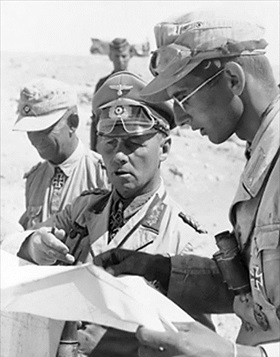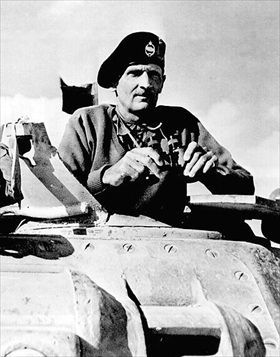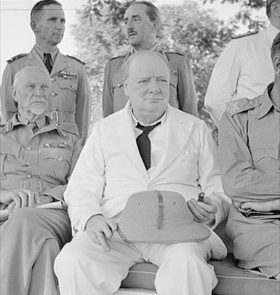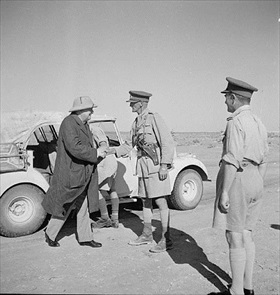CHURCHILL TO SHAKE UP NORTH AFRICAN COMMAND
Cairo, Egypt · August 5, 1942
On this date in 1942 British Prime Minister Winston Churchill and Gen. Sir Alan Brooke, chief of the Imperial General Staff, flew into Cairo. They arrived in the Egyptian capital 44 days after the British garrison at Tobruk in Eastern Libya had fallen to German Gen. (soon Field Marshal) Erwin Rommel of Panzerarmee Afrika, and just under a month after the British Parliament had taken up a censure motion against Churchill over his handling of the war against the Axis powers led by Germany’s Adolf Hitler and Italy’s Benito Mussolini.
Churchill and Brooke’s mission was to identify and punish a scapegoat for British military shortcomings in North Africa. British Eighth Army commander Gen. Claude Auchinleck and his deputy chief of staff were sacked and Lt. Gen. Bernard Law Montgomery placed in command. Brooke based his choice of 54‑year-old Montgomery on his qualities as a supremely professional soldier and a hard trainer of men—soon to include the legendary “Desert Rats,” a nickname the men of the Eighth Army in the Western Desert Campaign adopted. After 12 days of intense fighting in October 1942, the Second Battle of El Alamein proved a decisive victory for the reinvigorated Eighth Army, allowing “Monty” to turn tables on Rommel and recapture Tobruk in November and take Tripoli in Northwestern Libya in January 1943. A squeeze play by Monty in the south and Gen. Dwight D. Eisenhower in the west—Torch landings in November 1942 in Northwest Africa had put Eisenhower and his men there—forced Rommel’s unlucky replacement, Gen. Hans-Juergen von Arnim, standing in for the ailing Field Marshal on home leave, to surrender Axis armies in Tunisia in mid-May 1943.
Losing North Africa was a lethal blow to Mussolini, whose Fascist supporters in Rome dumped him in July 1943. Gen. Pietro Badoglio’s new Italian government promptly placed the deposed strongman under house arrest. The capture of eight Axis divisions (250,000 men and equipment) had left Sicily and the Italian mainland without adequate defenses to prevent the Allies from crossing the Mediterranean Sea and opening a second front on the European continent. The intent of Operation Husky, whose makeup consisted of Montgomery’s Eighth Army and Lt. Gen. George S. Patton’s U.S. Seventh Army, was to reduce pressure on the Soviets. Since June 1941 the Red Army single-handedly manned the European (Eastern) Front, bested Axis armies in the bloodiest campaign of the war at Stalingrad (August 1942 to February 1943), but had not been able to relieve the killer Siege of Leningrad (September 1941 to January 1944).
Dual in the North African Desert: Rommel vs. Montgomery, 1942
 |  |
Left: Field Marshal Erwin Rommel, Commander of the German forces in North Africa, with his aides during the desert campaign, spring 1942. Since June 1941 Axis and British forces had been trading blows across unforgiving reaches of the Libyan Desert in a contest to gain control of the Eastern Mediterranean. Nicknamed “the Desert Fox” (Wuestenfuchs), Rommel and his Italian allies seemed to be gaining the upper hand with the British loss of Tobruk, Lybia’s eastern fortress and deep-water harbor in June 1942, which put the Germans one step closer to shutting down Britain’s naval base at Alexandria, Egypt; gaining control of the Egyptian Suez Canal, the British lifeline to the British-held Indian subcontinent; and securing or destroying the Middle East’s valuable oil fields.
![]()
Right: Lt. Gen. Bernard Law Montgomery watches British Eighth Army tanks maneuvering during the Second Battle of El Alamein, October 23 to November 11, 1942. Churchill was thrilled by the British Army’s defeat of Rommel, nicknamed the “Desert Fox,” famously saying, “It may almost be said, ‘Before Alamein we never had a victory. After Alamein we never had a defeat’.”
 |  |
Left: Winston Churchill with members of his Imperial General Staff, British Embassy, Cairo, August 5, 1942. Directly behind him is Gen. Sir Alan Brooke and to Brooke’s right is Air Officer Arthur Tedder, RAF Middle East Commander who in 1944–1945 would serve as Deputy Supreme Commander at Supreme Headquarters Allied Expeditionary Force (SHAEF) under Gen. Dwight D. Eisenhower. Churchill, Brooke, and members of the Imperial General Staff were fresh from a late-June meeting with President Franklin D. Roosevelt and his Chiefs of Staff. Taking part in the discussions was Eisenhower. Together the Allied leaders plotted the Anglo-American invasion of Northwest Africa set for November 1942 (Operation Torch), which in six months cleared Axis forces from the whole of North Africa and opened the door for the invasions of Sicily (Operation Husky) and the Italian mainland (Operation Avalanche).
![]()
Right: In coat and pith helmet Churchill greets Lt. Gen. William Ramsden during a visit to the El Alamein front, August 7, 1942. Rommel’s Afrika Korps was only a few miles away. Ramsden’s XXX Corps, consisting principally of Australians, South Africans, and Indians, held the northern line at El Alamein, a line that Rommel’s men could not break.
BBC Presentation: Rommel’s Afrika Korps vs. Montgomery’s Eighth Army, North Africa 1942
![]()

 History buffs, there is good news! The Daily Chronicles of World War II is now available as an ebook for $4.99 on Amazon.com. Containing a year’s worth of dated entries from this website, the ebook brings the story of this tumultuous era to life in a compelling, authoritative, and succinct manner. Featuring inventive navigation aids, the ebook enables readers to instantly move forward or backward by month and date to different dated entries. Simple and elegant! Click
History buffs, there is good news! The Daily Chronicles of World War II is now available as an ebook for $4.99 on Amazon.com. Containing a year’s worth of dated entries from this website, the ebook brings the story of this tumultuous era to life in a compelling, authoritative, and succinct manner. Featuring inventive navigation aids, the ebook enables readers to instantly move forward or backward by month and date to different dated entries. Simple and elegant! Click 











